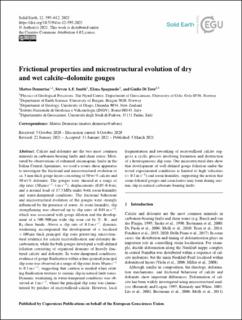| dc.description.abstract | Calcite and dolomite are the two most common minerals in carbonate-bearing faults and shear zones. Motivated by observations of exhumed seismogenic faults in the Italian Central Apennines, we used a rotary-shear apparatus to investigate the frictional and microstructural evolution of ca. 3mm thick gouge layers consisting of 50 wt% calcite and 50 wt% dolomite. The gouges were sheared at a range of slip rates (30 µm/s–1m/s), displacements (0.05–0.4 m), and a normal load of 17.5MPa under both room-humidity and water-dampened conditions. The frictional behaviour and microstructural evolution of the gouges were strongly influenced by the presence of water. At room humidity, slip strengthening was observed up to slip rates of 0.01m/s, which was associated with gouge dilation and the development of a 500–900µm wide slip zone cut by Y-, R-, and R1-shear bands. Above a slip rate of 0.1m/s, dynamic weakening accompanied the development of a localised <100µm thick principal slip zone preserving microstructural evidence for calcite recrystallisation and dolomite decarbonation, while the bulk gouges developed a well-defined foliation consisting of organised domains of heavily fractured calcite and dolomite. In water-dampened conditions, evidence of gouge fluidisation within a fine-grained principal slip zone was observed at a range of slip rates from 30µm/s to 0.1m/s, suggesting that caution is needed when relating fluidisation textures to seismic slip in natural fault zones. Dynamic weakening in water-dampened conditions was observed at 1m/s, where the principal slip zone was characterised by patches of recrystallised calcite. However, local fragmentation and reworking of recrystallised calcite suggests a cyclic process involving formation and destruction of a heterogeneous slip zone. Our microstructural data show that development of well-defined gouge foliation under the tested experimental conditions is limited to high velocities (> 0.1m/s) and room humidity, supporting the notion that some foliated gouges and cataclasites may form during seismic slip in natural carbonate-bearing faults. | en_US |

